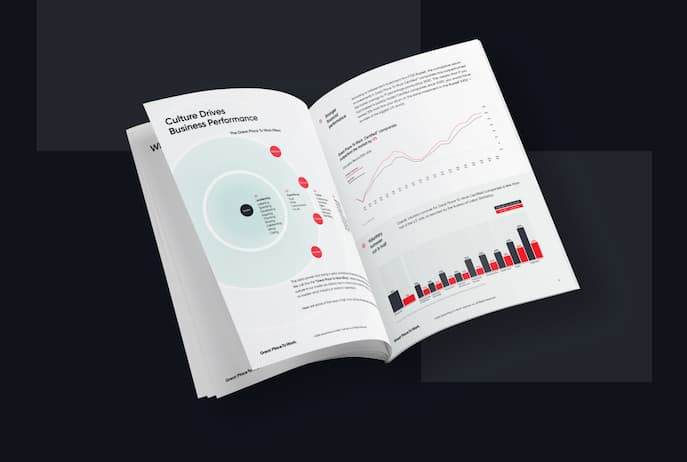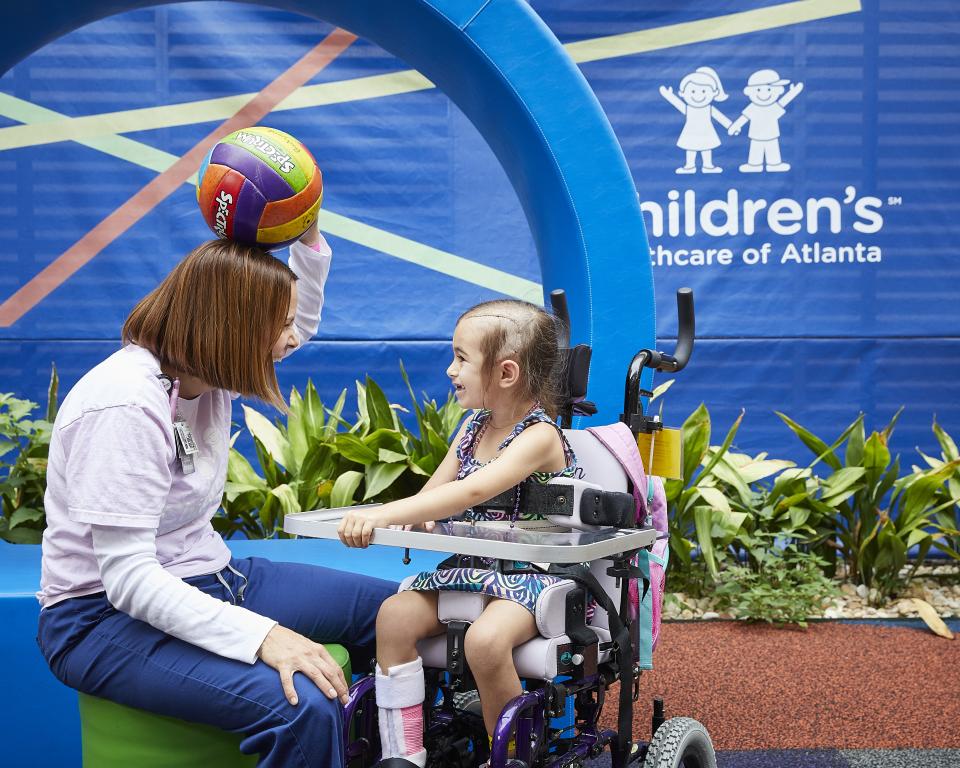Benchmarks & Trends, Celebrating, Employee Experience, Employee Recognition, Talent Management, Thanking
A culture of recognition develops engaged and loyal employees. Making employee appreciation integral to your workplace culture can be achieved through meaningful and intentional practices.
Recognition in the workplace helps employees see that their company values them and their contributions, fostering loyalty and engagement.
Creating an employee recognition program is a start—so if you don’t have one, that’s a good first step! As companies grow, this becomes even more of a challenge, and leaders must rethink the way they add value to the employee recognition experience.
Tips and strategies for connecting employee experience to the bottom lineREPORT
How High-Trust Culture Drives Business Success
What is employee recognition?
Employee recognition refers to all the ways an organization shows its appreciation for employees’ contributions. It can take many forms and may or may not involve monetary compensation.
There’s no one way to recognize employees; acknowledging people’s contributions can be formal, information, or a mix of both.
- Formal recognition is a structured way to acknowledge employee contributions in the form of tangible rewards, quarterly awards, performance-based bonuses, or milestone celebrations. SheetzFEST is an exemplary celebration of loyalty and commitment, showing appreciation with a fully hosted resort stay, reflecting how deeply the company values its employees’
- Informal recognition is more spontaneous and can be done at any time: Saying “thank you” during a one-on-one, a written acknowledgement of a team member’s effort, or recognizing employees publicly on internal communication channels. Sedgwick, a financial services company headquartered in Memphis, uses a program called “Props” to ensure employees can celebrate each other and connect with colleagues around the world.
Why is employee recognition important?
From a very early age, we crave recognition from parents, teachers and friends. So strong is our desire for positive affirmation, particularly during developmental periods, that we can even perceive a neutral reaction as a negative one.
This continues to hold true as we move into the workplace. Creating a culture of thanking and celebrating — two of the nine high-trust leadership behaviors every leader should model — will positively affect people’s sense of value and willingness to do their best work because they feel seen.
Employee recognition helps to:
- Retain top talent.Great Place To Work uncovered three common experiences that highly correlate to retention:
- 7x more likely to stay when they say their work is meaningful
- 2x more likely to stay when they report being proud of where they work
- 7x more likely to stay when they say their workplace is fun
Acknowledging employees goes a long way toward showing people that they matter to the company, both as an employee and as a person. Feeling valued and appreciated, celebrating the achievements of teams and the company foster camaraderie, pride, and purpose.
- Improve productivity.When employees feel overlooked or underappreciated, they don’t give their best effort. That unproductive labor can have a surprising price tag: the average annual cost to a company for every hour of “unproductive labor” is $15,000, according to McKinsey. Recognition is one way leaders can improve productivity. When employees say everyone can get special recognition, they are 56% more likely to give extra effort. That effort has a big impact on a company’s bottom line: the Fortune 100 Best Companies to Work For® out perform the market by 8.5 times.
- Boostmorale. When employees see their contributions celebrated, it helps create a vibrant, people-first culture that resonates through every level of the organization. Celebrating these moments builds fun, camaraderie, and a deep sense of pride and belonging that translates into higher engagement and well-being for everyone.
There's something invigorating about a workplace where recognition is more than just an end-of-year event. With over 700,000 survey respondents echoing this sentiment, it's hard to argue against the data.
Our 2023 discretionary effort study found that when each employee stands an equal chance at getting a gold star for their efforts, they are 2.2 times more likely to flex their discretionary muscles and go above and beyond their regular duties.
Recognition and employee engagement
Employee recognition is about more than a pizza lunch to reward the end of a special project. It’s a strategic tool that can greatly improve employee engagement.
“The employee experience is defined as the cumulative assessment of an employee’s interaction with your company and its people,” says Julian Lute, senior strategic advisor at Great Place To Work®. At great workplaces, recognition drives business success because it centers on the employee experience. When employees feel seen, they bring their best selves to work and are more likely to go above and beyond their regular duties.
One of the foundations of the employee experience is trust. Great Place To Work research backs this up:
- The 100 Best Companies experience 5x greater revenue per employee. Cumulative stock market returns among the publicly held Fortune 100 Best Companies to Work For® are 5x greater than the market average.
- Leads to innovation:Among the Best Workplaces™, 85% of employees report giving extra effort and 82% feel their colleagues are willing and able to adapt quickly to changes, versus 60% and 64%, respectively, at typical workplaces.
How management recognition fuels extra effort
The story doesn't end there. The study's spotlight also fell upon those at the helm—our much-respected management. It turns out, a genuine 'thank you' from those in the corner offices can ignite a 69% increase in the likelihood of employees bringing their extra effort to the work floor.
Great Place To Work® Certified™ company O.C. Tanner has also studied workplace dynamics and the role management plays in shaping them. They've examined employee engagement in depth and unearthed valuable ways managers can tailor their workplaces to spur it on.
An employee survey included the question, "What is the most important thing that your manager or company currently does that would cause you to produce great work?"
Respondents answered in their own words, providing a variety of responses, but a clear pattern emerged: 37% of respondents said that more personal recognition would encourage them to produce better work more often.
Recognition emerges as a top motivator
While other themes like autonomy and inspiration surfaced, recognition was the most common theme that emerged from responses. The study showed that affirmation, feedback and reward are most effective for motivating employees to do their best work.
See the complete results in the chart below:
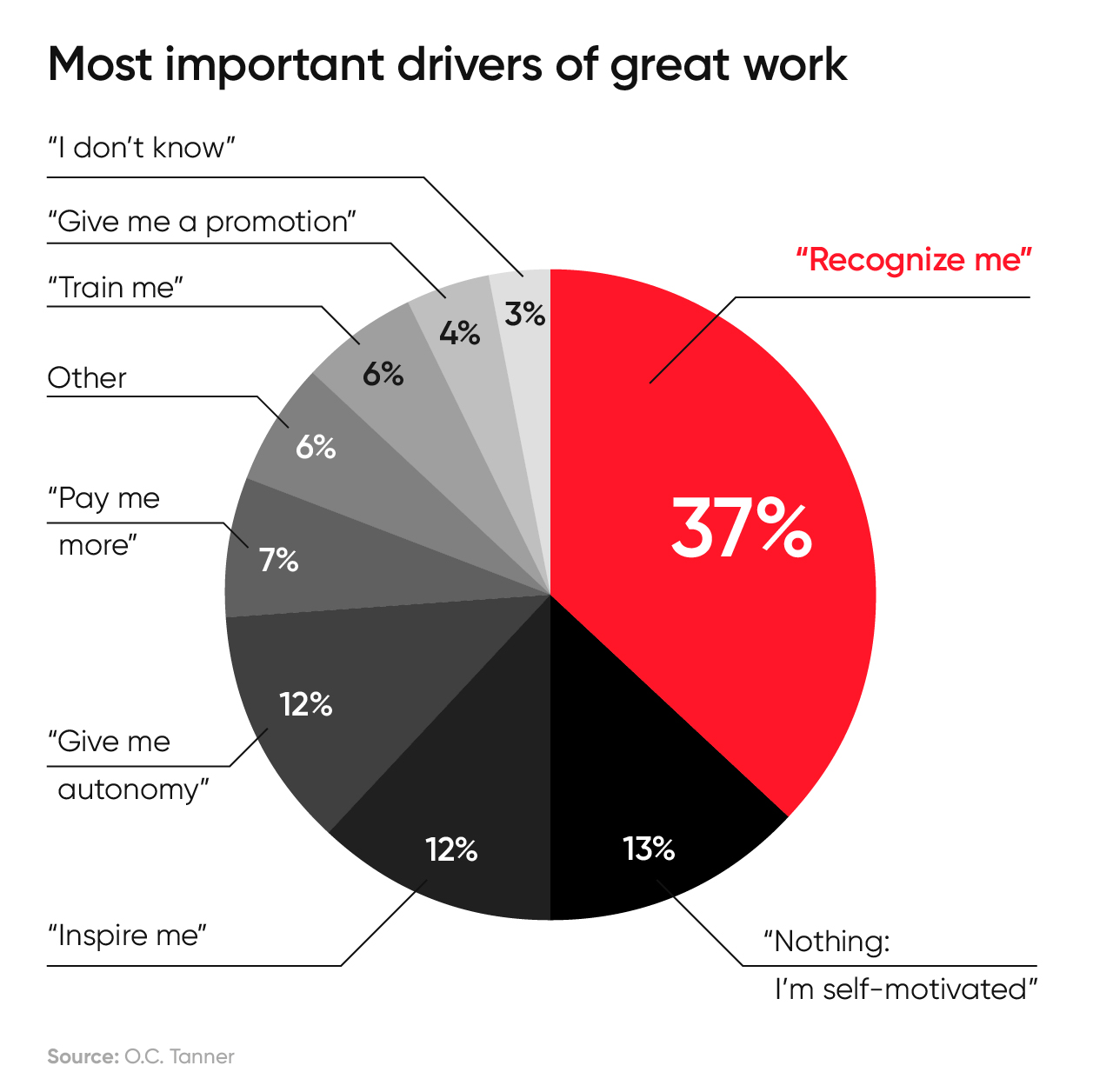
By narrowing in on several statements in the Great Place To Work Trust Index™ survey that measure how much employees feel recognized at work, we were able to see the impact of recognition culture on employee experience.
Great Place To Work analyzed 1.7 million employee survey responses gathered between 2018 and 2020 across small, mid-sized and large companies.
Recognition makes employees feel promotions are fair and spurs innovation
After comparing the overall experience of employees who received recognition to those who don’t, we found that recognition was strongly tied to several elements of positive company culture.
Compared to those who do not consistently feel recognized at work, people who do feel recognized at work are:
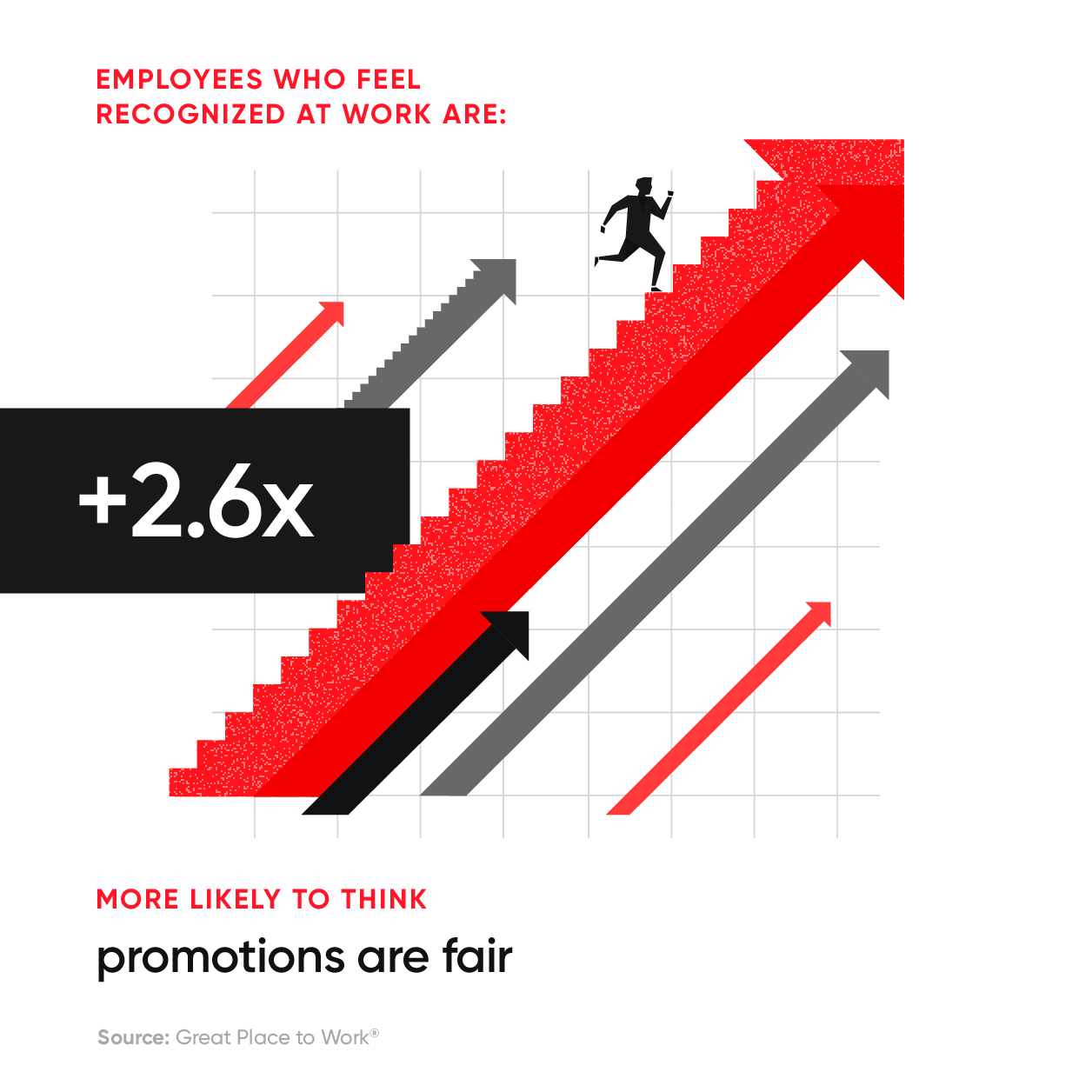
Employee appreciation is linked to higher job satisfaction
In the same Trust Index survey, when asked what makes their workplace “great,” employees who responded positively to survey questions measuring recognition say that they are “incredibly lucky,” “enjoy hanging” and that the company has “excellent integrity,” “uplifting environment” and some mentioned their “career success.”
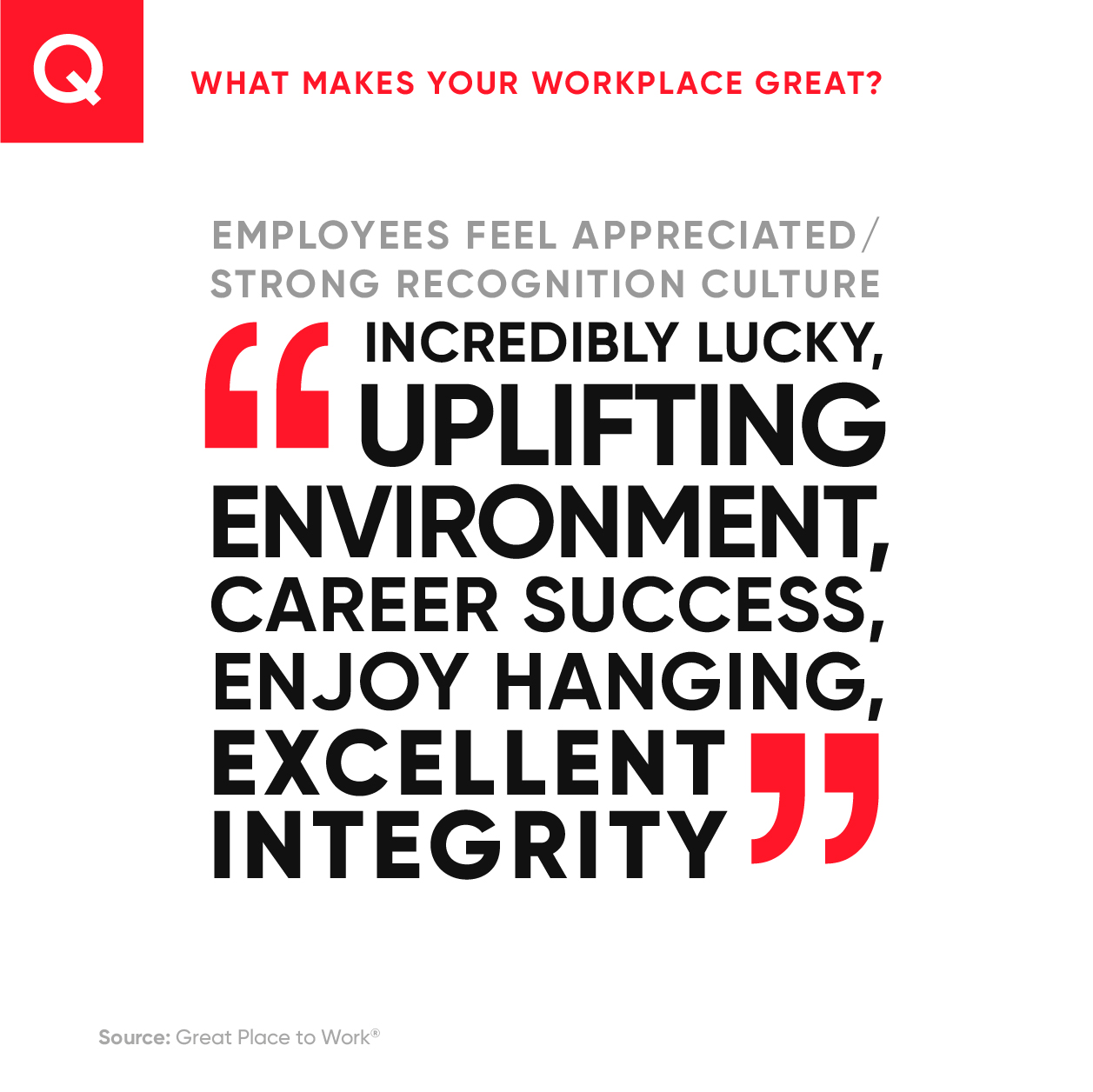
Employees who don’t feel recognized also struggle to describe what makes their workplace great
Conversely, employees who don’t feel recognized at work responded to the same question with phrases such as “plays favoritism” and “popularity contest,” indicating there isn’t much that makes their workplace great. The only positive theme was “match benefits.”
When asked what would make their company better, the employees who felt unrecognized responded with phrases that indicated feelings of unfair treatment and a manipulative work environment. Words such as “rampant favoritism,” “scare tactics,” “stop eliminating,” and “job tomorrow” were most common among the “unrecognized” group.
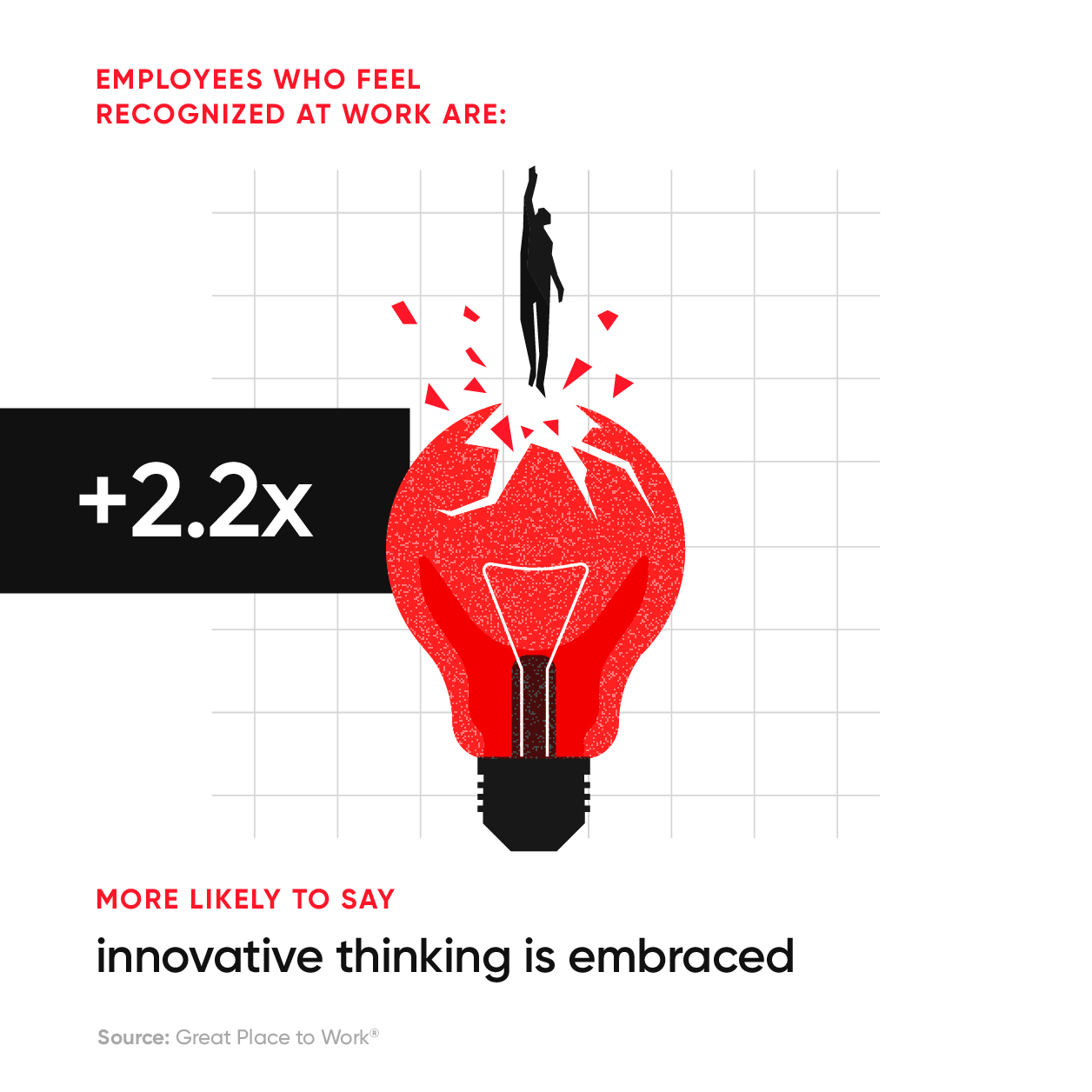
Employee Recognition Trends
Democratize recognition
Being recognized by one’s peers can be just as meaningful as recognition that comes from the top down. It also:
- Increases the number of opportunities for employees to receive recognition by widening the pool of potential recognizers
- Reinforces desired behaviors without resorting to explicit, top-down direction
At software company Atlassian, the Kudos program enables team members to recognize their coworkers’ hard work and achievements. An employee might receive Kudos when going above and beyond, or after completing a long project. Kudos can be accompanied by gifts ranging from gift cards to books to wine. Last year, employees awarded nearly 56,000 Kudos.
Law firm Alston & Bird LLP uses its quarterly newsletter to share the ways that team members are engaging with the surrounding community.
Ally Financial’s “I am an Ally” award program invites team members to nominate colleagues for their contributions and impact, whether their work affects customers, internal teams, or specific individuals. Internal feedback has shown the popularity of this program and its impact on employee motivation.
By putting the power to recognize in everyone’s hands, you can create a sustainable, authentic source of employee recognition.
Celebrate major achievements — but don’t forget the small wins
You might find that it’s easier to recognize employees in some departments or roles than in others. This might be because their work is closely related to a major company initiative or KPI, or because what they produce is more visible than the work done in other departments.
It’s great to celebrate these big wins! Just don’t forget about celebrating those smaller or less obvious successes, too.
Recognizing employees whose work doesn’t naturally call attention to itself can help reinforce their sense of purpose at work, a key driver of employee retention.
Hilcorp Energy Company recently recognized the importance of celebrating small successes. The oil and gas producer already had a “Big Wins” program that regularly celebrated successes in both the office and the field. But while this program created a lot of employee recognition opportunities, Hilcorp leadership realized that it was overlooking critical successes that weren’t necessarily as large or flashy as the Big Wins. So the company changed the program to “Hilcorp Win” and began celebrating a mix of large and small victories.
Wegmans Food Markets recognizes stores and employees for their contributions to the company winning awards, generating customer compliments, and living the company’s values, but they also make a point to highlight achievements that might otherwise fly under the radar. Wegmans recognizes stores for having the highest recycling rate, the fewest workplace safety claims, and the best food safety assessments.
When designing or updating your employee recognition program, consider what critical but easy-to-overlook areas of your organization you can make a note to celebrate.
5 keys to meaningful employee recognition programs
Many Great Place To Work® clients, even those with strong company cultures, face challenges when it comes to team and individual employee recognition.
While there is no universal program for every organization, all managers can use these five key elements of meaningful employee recognition.
1. Be specific, be relevant
Recognition is more meaningful when tied to a specific accomplishment or business objective. When recognizing employees, explaining what the recognition is for helps employees relate the recognition to their behavior. This encourages continued strong performance.
Authentic appreciation is also tailored to the individual. Which of the five languages of appreciation in the workplaceyou choose to express should depend on what people prefer.
2. Be timely
Recognition that arrives months after the fact isn’t nearly as meaningful as recognition received promptly.
The longer it takes for managers to recognize employees, the less likely employees will see the affirmations as authentic. Make employee recognition a priority and have formal recognition systems in place so you can strike while the iron is hot.
3. Recognition comes in many shapes and sizes
There is a great deal of research that indicates people are motivated by more than just cold hard cash. It is also important to note that everyone has their own preference or style when it comes to giving and receiving appreciation.
Get a clearer picture of the primary language of appreciation (in a work setting) of every individual. Then, recognize them accordingly.
Beyond a bonus or a raise, consider customized gifts, taking them out for dinner or other acts that show employees their reward is personalized to them.
4. Little things go a long way
While it's crucial to recognize major accomplishments, don’t overlook the power of the everyday thank-you to motivate employees.
Writing handwritten notes, or using the intranet to promote the good behaviors of individuals, can help instill a regular culture of employee recognition. These thank-yous and shout-outs don’t have to come from managers alone; some employees may find recognition more motivating when it comes from their peers rather than from leadership.
5. Connect to the bigger picture
Recognition helps employees see that their company values them and their contributions to the success of their team and the company overall.
This is particularly key when organizations grow or change. It helps employees build a sense of security in their value to the company, motivating them to continue great work.
Regularly share news about how the company is striving to reach the mission, and explain how individual employee goals relate to that vision.
Organizations on the Fortune 100 Best Companies to Work For® list excel in employee recognition.
Here are some examples of how these winning organizations recognize and reward their employees in meaningful ways:
Employee recognition ideas
1. Employee-of-the-month programs
An employee-of-the-month program sounds like it belongs in the past along with cubicles, however, it can be an effective and straight forward tool in creating a culture of recognition.
Consider the following points when implementing an employee recognition program:
- Define the criteria.Establish what qualifies people to be considered Employee of the Month. Are the criteria tied to specific metrics, or behaviors that align with company values, such as teamwork, innovation, or leadership? Once you’ve defined your criteria, share them, along with examples of behaviors or values you are looking to reward.
- Be transparent and fair.Having a single manager decide on who should be recognized each month could lead to bias. To avoid favoritism, seek nominations from a diverse group that includes both managers and peer Bring together a panel of people across the organization to choose winners. Alternatively, rotate recognition between different departments.
- Make it meaningful.Take your employee-of-the-month program from good to great by personalizing the rewards and recognition to the individual. This could be as simple as a thoughtful handwritten note, or a gift that reflects what the winner values and shows them that you see and appreciate them.
Keep your employee-of-the-month program fresh and engaging by mixing things up.
- Create a custom, heartfelt video on why they were nominated (this could also be shared on your social media channels — with their permission)
- Gift them an unforgettable experience such as a hot air balloon ride, concert tickets, or fancy dinner for two with their plus one
- Make a donation to a charity that is meaningful to them in their honor.
- Involve their team members with a team lunch, fun execution such as bowling or ice skating, or team cooking class
- Pair your winner with a senior leader for a lunch or coffee chat where they can ask questions about their career
Global hotel chain Hilton provides managers an annual Recognition Calendar that features 365 no- and low-cost, easy-to-implement ideas for thanking employees.
The calendar includes reminders and tips for enterprise-wide, brand and department recognition programs; appreciation best practices; important dates like International Housekeeping Week; and recognition quotes to share with employees.
It also allows users to add employee service anniversaries and local events. Users can download a print-friendly PDF or import an Outlook-friendly file into their personal calendars.
2. Public praise and acknowledgement
If words of affirmation is one of your employees’ language of appreciation, then public praise is one way to show your appreciation.
These can be verbal or written. Whichever approach you take, be as specific as possible. A generic “good job” won’t be as compelling or effective as taking the time to compliment a certain skill set or action. Public acknowledgement can take the form of speaking positively about a person in a one-on-one meeting, at the beginning of a team meeting, or on stage at a Town Hall event.
When clients of professional services firm Crowe respond to a satisfaction survey with the names of individuals who have gone above and beyond during projects, the survey generates a "Recognize Alert."
Crowe takes Recognize Alerts one step further with its Pay It Forward program. Individuals who were recognized can "pay it forward" to other colleagues who played important roles in serving clients but weren't mentioned in the survey response.
Crowe shares the names of both Recognize Alert and Pay It Forward recipients in Crowe Newswire On Demand so others can learn from their examples and the individuals feel appreciated.
3. Personalized thank-you notes
Written affirmations are another form of recognition for employees who value words of affirmation. Ask yourself whether the recipient prefers public or private praise. Expressing gratitude can range from a handwritten note to a shoutout on a team Slack channel, to public praise in a company-wide email. The key is to personalize your message: be specific about why they’re being recognized, acknowledge their impact, and express your thoughts sincerely.
Health care system Texas Health Resources recognizes employees' milestone years of service at five-year increments.
At every milestone, honorees receive a beautiful customized celebratory yearbook. Each yearbook opens with a personalized congratulatory message of appreciation from the CEO. Inside, the honoree finds messages of thanks and appreciation from their manager and coworkers, as well as photos of the employee at work with their team, having fun and contributing to the mission.
Recognition is absolutely essential in a great workplace, and it doesn't need to be complicated or expensive.
Ask your employees what type of recognition is most meaningful to them. You may be surprised to find how much simple, genuine expressions of thankfulness inspire them to do their best.
4. Performance-based bonuses
Performance-based bonuses are common in sales roles, but it can also be part of how companies recognize employees across all roles.
Employees at the Fortune 100 Best Companies to Work For® give extra in droves and are extremely agile, fueling higher revenue. On average, the 100 Best Companies earn 8.5 times more revenue per employee than the U.S public market RPE.
What to consider when creating a fair performance-based bonus system:
- Tie bonuses to objective performance metrics, rather than subjective opinion, and communicate them to your people
- Structure the bonus system so it’s inclusive of employees at all levels or departments
- Reward employees with a bonus amount that is large enough to matter and be something they want to strive for
Great workplaces ensure their employees can equally participate in being rewarded for their company’s success.
At NuStar Energy, every employee receives an annual bonus, regardless of what role they play at the company. If the CEO gets a bonus, everyone at the company is getting a bonus.
At Bright Horizons, executive team members are empowered to give spontaneous bonuses to recognize their significant contributions to achieving the executive’s team goals.
5. Peer-to-peer recognition programs
At great workplaces, providing recognition isn’t limited to managers. While employees love to get plaudits from the CEO, what happens when you are a global company with a distributed workforce?
For Atlassian, the answer was to ensure that everyone could recognize a colleague for a job well-done through their recognition program, Kudos.
Peer recognition offers multiple benefits:
- It reinforces company values and behaviors.
- It increases opportunities for recognition across the business.
- It builds stronger bonds and camaraderie between colleagues
- It fosters a more positive and supportive company culture
How Atlassian’s Kudos program works is a team member selects a company value which they’re nominating their peer for and submits with a short note about why their colleague deserves recognition. Those who are recognized usually receive a digital gift voucher or a donation to one of Atlassian’s charity partners.
Employees can also nominate their colleagues for “Big Kudos” for demonstrating leadership during complex, high-impact projects, which a manager then must approve.
6. Social media shout-outs
As any people manager knows, social media is one of the most important tools in your kit, providing instant reach to your audience in real time. Featuring your people and values is just as important as marketing your goods and services.
Showcasing employee recognition on social media is one of the best ways to market your company for little to no cost, create a culture of recognition, and attract top talent.
Here are some guidelines for sharing employee stories:
- Obtain consent. Before posting, ask employees for informed permission on where and how their story will be shared.
- Respect privacy. Be mindful of posting sensitive or personal information that could infringe on their privacy or make them feel uncomfortable
- Be authentic. Authenticity shines through. Avoid overly editing company stories and let your employees’ voice shine through.
TP took their employee stories to the next level in the UK by celebrating several of their employees:
TeleperformanceUK on X: "This is Michael's journey. It didn't quite work out the way he planned it would 😃 Spoiler: It worked out even better 🙌 Your Success is Our Success 🤩Teleperformance. Inspired To Be The Best. #GPTWCertified #InspiredToBeTheBest #LifeAtTP https://t.co/DakmE3qFTI" / X (twitter.com)
Edrington UK honored the women on its team for International Women’s Day last year, through a fun videohighlighting why each woman had been nominated for recognition.
What do you say when recognizing an employee?
True gratitude is more than just a polite “thank you.” It’s a genuine appreciation for someone, expressed to them. That could be as simple as telling them you value their efforts, or something more formalized, such as written recognition or an award.
Here’s some tips to consider when recognizing an employee:
- Be specific. Instead of a generic “good job,” mention what you valued about someone’s work when recognizing their contribution.
- Emphasize how their work contributed to the teams or company’s success.
- Acknowledging effort is as important as the results. This shows you value persistence as much as achievement and helps unlock innovation.
- Learn how each team member prefers to be thanked and tailor recognition accordingly. Would they prefer public praise or a private note?
Overcoming common challenges in employee recognition
While there are benefits to creating a culture of recognition, there are blind spots companies can overlook.
Here's some common challenges in employee recognition and how to overcome them:
- Recognition is infrequent – If recognition efforts are spotty, employees may feel underappreciated or become disengaged.
Instead, make shout-outs part of regular communications. This could mean a shout-out portion in your weekly team meetings and internal newsletters, or a dedicated channel for kudos on your intranet.
- Perceived favoritism – If the same five employees always get recognized, leaders should investigate the cause. Fairness is a key element of company culture and without it, employee experience will suffer.
To overcome this, ensure that recognition is consistent, transparent, and based on clear criteria. Great workplaces understand that every employee, regardless of role, work location, or experience should have the opportunity to receive recognition.
- Not involving your people – While it feels good to be celebrated, if it’s up to one or two people to create an employee recognition program, you could be missing out. Great workplaces understand the importance of listening to build engagement.
Soliciting regular employee feedback, such as through a dedicated employee recognition committee, or Great Place To Work’s employee engagement software, can help you to measure the impact of your gratitude initiatives and adjust accordingly.
Building a culture of appreciation
Your people are critical to the success of your organization, which is why celebrating employees for their efforts should be an integral part of company culture.
The benefits of creating a culture of appreciation goes beyond lifting employees’ spirits. Recognizing good work boosts people’s motivation, reinforces company values, drives innovation, and enhances performance.
Showing appreciation doesn’t need to be complicated. Whether recognition is big or small, public or private, comes from a senior leader or a peer, what matters is it’s authentic.
Listening to your employees is key to running a successful recognition program. Surveys provide invaluable insights into measuring the success of current recognition programs and aligning practices with what is most meaningful to people.
Frequently Asked Questions:
What is a culture of recognition in the workplace?
A culture of recognition is a workplace environment where employee appreciation is embedded into daily practices. It involves consistently acknowledging employees' contributions, achievements, and behaviors that align with company values.
Why is employee recognition important?
Employee recognition boosts engagement, loyalty, and performance. When employees feel valued, they are more likely to stay with the company, go above and beyond in their roles, and contribute to a positive workplace culture.
How can companies create a culture of recognition?
Companies can create a culture of recognition by implementing intentional practices such as peer-to-peer recognition, manager shout-outs, celebrating milestones, and aligning recognition with company values. Consistency and authenticity are key.
What are some effective employee recognition strategies?
Effective strategies include personalized thank-you messages, public recognition, awards for achievements, and integrating recognition into performance reviews. Recognition should be timely, specific, and meaningful.
Does recognition from management make a difference?
Yes, recognition from management significantly impacts employee motivation. Studies show that a simple 'thank you' from leadership can increase the likelihood of employees putting in extra effort by up to 69%.
Turn culture insights into business wins
Let the Trust Index™ Survey reveal your workplace’s hidden strengths and areas for growth. Start transforming today.




